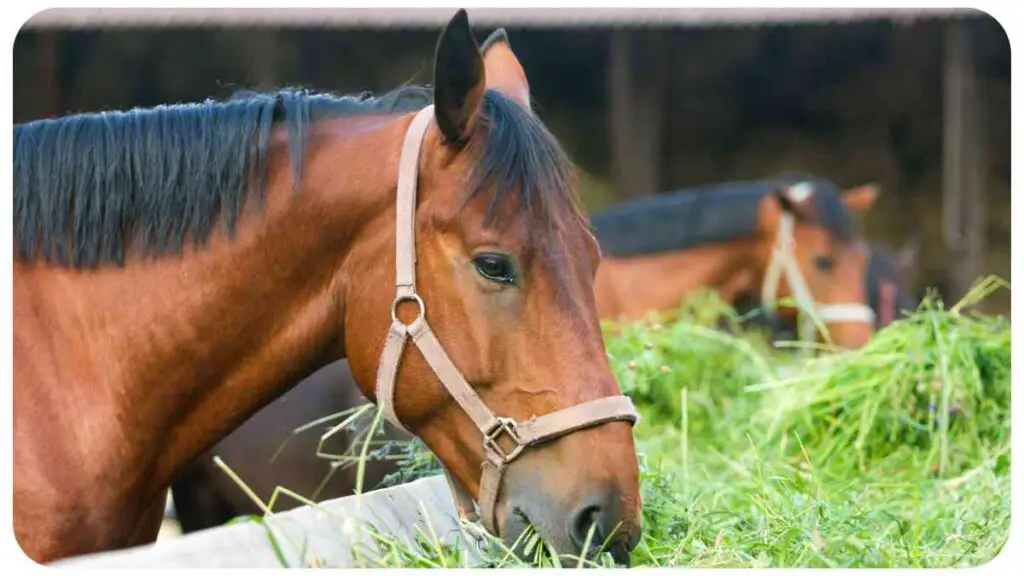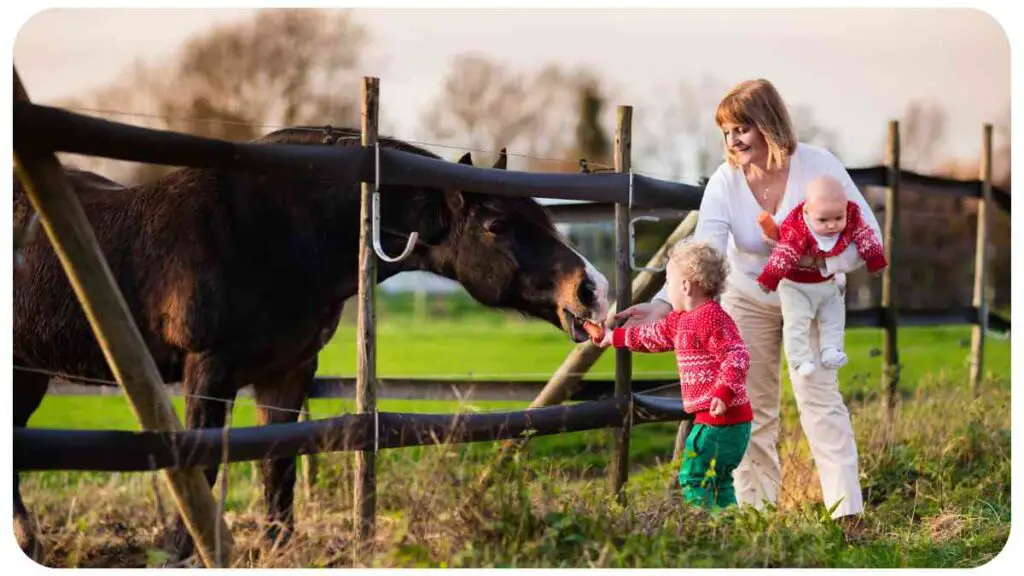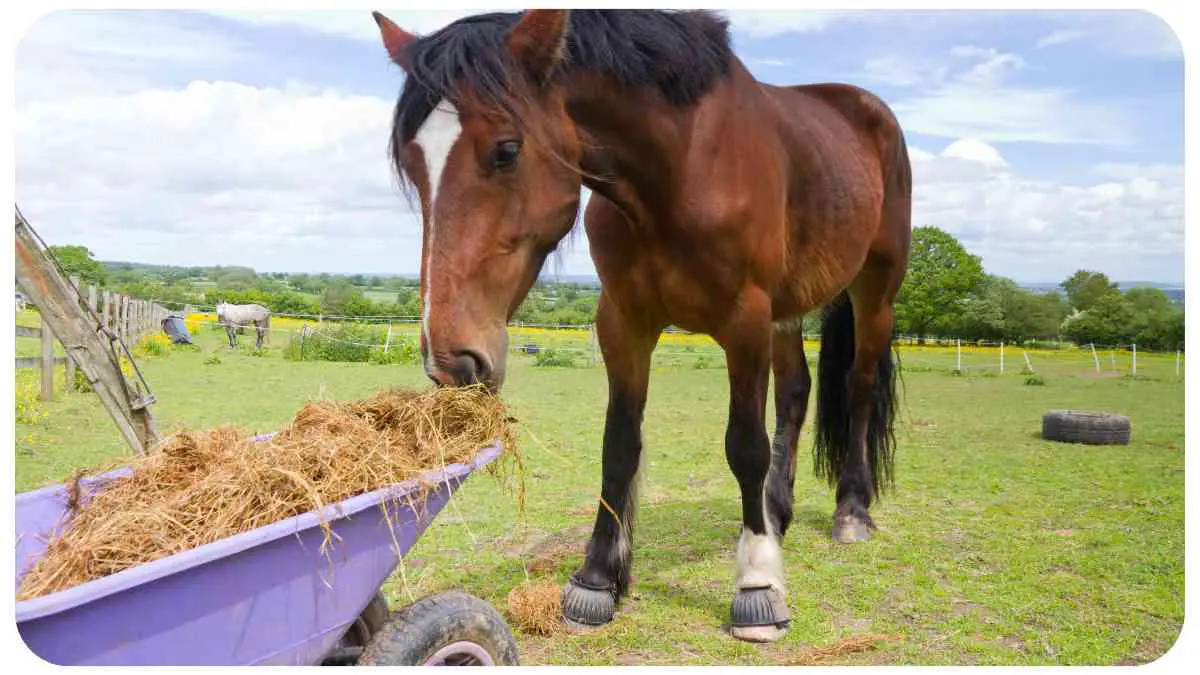Welcome to our comprehensive guide on decoding horse feed labels. As a horse owner, it’s essential to understand the information provided on feed labels to ensure the nutrition and well-being of your equine companion. Deciphering these labels can be a complex process, as it involves assessing various aspects such as nutritional composition, feeding recommendations, and ingredient list.
In this article, we will break down the key components of horse feed labels, providing you with the knowledge and tools to make informed decisions about your horse’s diet.
| Takeaway |
| Understanding horse feed labels is essential for providing a well-balanced diet for your horse. |
| Key components to focus on when reading a horse feed label include the guaranteed analysis, ingredient list, and feeding recommendations. |
| The guaranteed analysis provides information about protein, fat, fiber, and moisture content in the feed. |
| The ingredient list helps identify specific components, potential allergens, and the quality of ingredients. |
| Following the feeding recommendations ensures your horse receives the appropriate amount of nutrients and energy. |
| Horses require essential vitamins and minerals for optimal health, so it’s important to consider their inclusion in the feed. |
| Consulting with a professional, such as an equine nutritionist or veterinarian, is recommended for personalized guidance and advice. |
| Regular monitoring and adjustment of the feed amount may be necessary based on your horse’s weight, coat condition, and energy levels. |
| Comparing different horse feed brands allows for a tailored selection based on your horse’s specific needs. |
| Proper nutrition and understanding of horse feed labels can contribute to your horse’s overall health, vitality, and performance. |
2. Understanding Nutritional Requirements for Horses
Before delving into the intricacies of horse feed labels, it’s crucial to have a solid understanding of your horse’s nutritional needs. Horses require a balanced diet to maintain optimum health and performance. Their primary diet consists of forages, such as hay or grass, supplemented with concentrates and additional nutrients as necessary.
“When it comes to feeding your horse, it’s important to know the 10 secrets for optimal health and performance. From selecting the right feed to understanding portion sizes, feed your horse for optimal health and performance with these valuable tips.
3. Reading and Analyzing Horse Feed Labels

Decoding the information provided on horse feed labels is the first step in ensuring that you’re providing your horse with a nutritionally balanced diet. Let’s explore the key sections that you need to understand.
3.1 Types of Horse Feed
Horse feed generally falls into three main categories: concentrates, forages, and supplements. Each type has its own purpose and nutritional composition.
3.1.1 Concentrates
Concentrates, also known as grain mixes or complete feeds, provide a concentrated source of calories and nutrients. These feeds are typically high in energy and protein and are designed to be fed in conjunction with forage. Concentrates are an excellent option for horses with higher energy demands, such as those in intense work or growth stages.
Decoding horse feed labels requires an understanding of proper forage in a horse’s diet. Learn why proper forage in a horse’s diet is crucial for their overall health and wellbeing, and how it relates to selecting the right feed.
3.1.2 Forages
Forages form the basis of a horse’s diet and consist of hay (dried grass or legumes) and grass. They provide essential fiber and nutrients necessary for a healthy digestive system and proper nutrition.
3.1.3 Supplements
Supplements are additional nutrients that can be added to a horse’s diet to address specific deficiencies or enhance performance. These may include vitamins, minerals, and various nutritional additives.
3.2 Guaranteed Analysis
The guaranteed analysis section of a horse feed label provides key information about the feed’s nutritional content. It typically includes the percentages of crude protein, fiber, fat, and moisture present in the feed.
| Nutrient | Percentage |
| Crude Protein | 14% |
| Crude Fat | 5% |
| Crude Fiber | 12% |
| Moisture | 10% |
3.3 Ingredient List
The ingredient list outlines the components used in manufacturing the horse feed. Ingredients are listed in descending order by weight. A good horse feed will typically have a high-quality protein source, digestible fiber, and a balanced mix of vitamins and minerals. It’s important to pay attention to the ingredients listed, as certain horses may have sensitivities or allergies to specific components.
Discover the top 15 supplements that every horse owner should know about. From joint support to nutritional boosts, these supplements play a key role in equine health. Find out how to incorporate them into your horse’s diet by exploring the top 15 supplements every horse owner should know about.
3.4 Feeding Recommendations
The feeding recommendations section provides guidelines on how much of the feed to give your horse based on their weight, age, and activity level. It’s crucial to follow these recommendations to ensure your horse receives the appropriate amount of nutrients and energy.
3.5 Crude Protein and Amino Acids
Proteins are essential for muscle development, tissue repair, and overall growth in horses. The crude protein content listed on the feed label indicates the amount of protein present. Additionally, some horse feed labels may also provide information about specific amino acids, such as lysine and methionine, which are crucial for muscle development.
3.6 Fats and Oils
Fats and oils are an excellent source of energy for horses. They provide a concentrated calorie source, which can be beneficial for horses with high energy requirements or those needing weight gain. The fat content in horse feed can vary, so it’s important to consider the specific needs of your horse when making a selection.
Understanding your horse’s fitness needs is vital for their overall health and performance. Learn about the amount of exercise your horse requires and how it relates to their nutritional needs, decoding horse feed labels, and achieving optimal fitness levels by visiting how much exercise does your horse need?.
3.7 Fiber Content
Fiber is an essential component of a horse’s diet as it aids in proper digestion and supports a healthy gut. The feed label should indicate the percentage of crude fiber present in the feed. Consider the fiber content and the type of fiber source used when choosing the appropriate feed for your horse.
3.8 Vitamins and Minerals
Horses require a range of essential vitamins and minerals to maintain optimal health. The feed label should specify the vitamins and minerals present in the feed, such as vitamin A, vitamin E, selenium, zinc, and copper. Ensure that the feed you choose provides a well-rounded supply of these nutrients.
3.9 Additives and Non-Nutritional Ingredients
Some horse feeds may contain additives or non-nutritional ingredients, such as preservatives or flavor enhancers. It’s important to be aware of these additional components and assess their suitability for your horse’s specific needs.
3.10 Specialized Diets and Medication
Certain horses may require specialized diets due to specific health conditions or restrictions. It’s crucial to consult with a veterinarian or equine nutritionist when considering a specialized diet or when incorporating medication into your horse’s feed routine. They can provide guidance on the best course of action and ensure your horse’s well-being.
4. Comparing Horse Feed Brands

Now that you understand how to decipher horse feed labels, let’s take a closer look at some popular horse feed brands and compare their nutritional compositions. Remember that this comparison is for illustrative purposes, and it’s always best to consult with a professional before making any significant changes to your horse’s feeding regimen.
Prevent common horse illnesses and ensure the wellbeing of your equine companion. Gain insights into identifying and preventing common horse illnesses to make informed decisions about the feed you provide. Find out more at common horse illnesses: what it means and how to prevent them.
4.1 Brand A: Horse Feed
Table: Nutritional Composition of Horse Feed
| Nutrient | Percentage |
| Crude Protein | 16% |
| Crude Fat | 4% |
| Crude Fiber | 10% |
| Moisture | 12% |
| Vitamin A | 10000 IU |
| Vitamin E | 500 IU |
| Calcium | 0.8% |
| Phosphorus | 0.6% |
| Copper | 50 ppm |
| Zinc | 120 ppm |
4.2 Brand B: Horse Feed
Table: Nutritional Composition of Horse Feed
| Nutrient | Percentage |
| Crude Protein | 14% |
| Crude Fat | 6% |
| Crude Fiber | 12% |
| Moisture | 15% |
| Vitamin A | 8000 IU |
| Vitamin E | 400 IU |
| Calcium | 1% |
| Phosphorus | 0.7% |
| Copper | 40 ppm |
| Zinc | 100 ppm |
4.3 Brand C: Horse Feed
Table: Nutritional Composition of DEF Horse Feed
| Nutrient | Percentage |
| Crude Protein | 15% |
| Crude Fat | 5% |
| Crude Fiber | 8% |
| Moisture | 10% |
| Vitamin A | 9000 IU |
| Vitamin E | 450 IU |
| Calcium | 0.9% |
| Phosphorus | 0.5% |
| Copper | 60 ppm |
| Zinc | 150 ppm |
5. Tips for Choosing the Right Horse Feed
When it comes to selecting the appropriate horse feed for your equine partner, consider the following tips:
5.1 Assessing Your Horse’s Needs
Evaluate your horse’s age, weight, activity level, and overall health. Different horses have varying nutritional requirements, so understanding your horse’s specific needs is crucial.
5.2 Consulting with a Nutritionist
Seek guidance from an equine nutritionist or veterinarian who can assess your horse’s nutritional needs and recommend suitable feed options.
5.3 Evaluating the Nutritional Profile
Compare the nutritional composition of various horse feed brands, paying attention to the levels of protein, fat, fiber, vitamins, and minerals that align with your horse’s requirements.
5.4 Considering Feeding Options
Choose a horse feed that suits your horse’s feeding schedule and preferences. Some feeds may need to be fed multiple times a day, while others can be provided as a single daily meal.
5.5 Monitoring and Adjusting
Regularly monitor your horse’s weight, coat condition, and energy levels. Adjust the feed amount if necessary, following the feeding recommendations provided by the brand or as advised by a professional.
6. Conclusion
Decoding horse feed labels may initially seem daunting, but with the knowledge and insights provided in this step-by-step guide, you can make informed decisions about your horse’s nutrition. Remember to consider your horse’s individual needs, consult professionals when necessary, and keep an eye on their overall well-being.
By deciphering feed labels, comparing brand compositions, and understanding their nutritional benefits, you can ensure a well-balanced diet for your equine companion, promoting health, vitality, and optimal performance. Happy feeding!
Note: The nutritional composition tables provided in this article are for illustrative purposes only and do not represent real brand data. It is essential to refer to the actual packaging and consult professionals for accurate and up-to-date information on specific horse feed brands.
Further Reading
Here are some additional resources to further your understanding of decoding horse feed labels:
HorseandRider.com – Read a Feed Tag: This article provides a comprehensive guide on how to read and understand the information on horse feed tags, including a breakdown of key components and their significance.
University of Nebraska-Lincoln: Basics of Feeding Horses – Reading the Feed Tag: This document from the University of Nebraska-Lincoln covers the basics of reading a horse feed tag, discussing nutritional requirements, interpreting the feed analysis, and understanding various terms and definitions.
Star Milling Co. – Understanding Horse Feed Labels: This article provides a concise overview of understanding horse feed labels. It covers key components of feed labels, explains common terms, and offers insights into nutritional requirements.
FAQs
What should I look for in the guaranteed analysis section of a horse feed label?
The guaranteed analysis section provides important information about the nutritional content of the feed, including the percentages of crude protein, fat, fiber, and moisture. It helps assess the suitability of the feed for your horse’s specific needs.
Should I consider the ingredient list when choosing a horse feed?
Yes, the ingredient list is crucial as it gives you insight into the key components used in manufacturing the feed. Look for high-quality protein sources, digestible fiber, and a balanced mix of vitamins and minerals. Be aware of any ingredients that your horse may have sensitivities or allergies to.
How do I determine the appropriate amount to feed my horse?
The feeding recommendations section on the horse feed label provides guidelines based on your horse’s weight, age, and level of activity. It’s important to follow these recommendations as they help ensure your horse receives the right amount of nutrients and energy.
Are there specific vitamins and minerals that are important for horses?
Yes, horses require a range of essential vitamins and minerals for their overall health. Some important ones include vitamin A, vitamin E, selenium, zinc, and copper. Ensure that the feed you choose provides an adequate supply of these nutrients.
Should I consult with a professional before making changes to my horse’s diet?
It is highly recommended to consult with an equine nutritionist or veterinarian before making any significant changes to your horse’s diet. They can assess your horse’s specific needs and provide expert guidance to ensure the best nutrition and health outcomes.

Hi there! My name is Hellen James, and I’m a horse riding expert. I’ve been riding horses since I was just a kid—and it’s been my passion ever since. But getting started with horse riding can be overwhelming. There’s so much to learn! If you’re looking for a way to get started and make sure you’re doing it right, I’m here to help.


